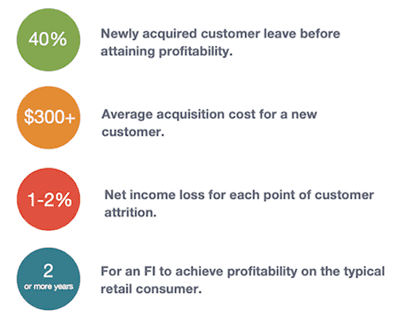Financial Institutions are losing customers and revenue because they don’t have an ongoing strategy to manage attrition that is based on data.
– The Financial Brand
At a cost of more than $300 to acquire a new customer2, and FIs losing 10-15% annually of gross revenues to attrition3, FIs must slam the door on attrition.
Research shows that by employing artificial intelligence powered predictive analytics and arming relationship managers with data-driven insights and enablers, financial institutions can reduce total attrition by 20% to 30%—a result that would nearly double most banks’ average revenue growth.3
FI’s need to employ a data-driven strategy aligned with having an on-demand process in place to identify customers with potential churn risk before it’s too late.
Managing attrition is not a new paradigm hitting the financial industry; however, consumer banking behavioral shifts to fintech disruptors and fluctuations in purchase spend patterns brought on by the pandemic have brought heightened concerns and a greater need for a solution to stem attrition.
The importance of retention and having a modern-day approach to battling attrition is directly tied to the bottom line for a financial institution. Profitability is a function directly tied to lifetime value — the longer your relationship with a consumer, the better chance the consumer will become profitable1. While the thought may be your institution has a grasp on the profitability of your customers and their individual churn risk, contemplate these statistics:

Customer retention is critical in the ultra-competitive environment we live in4 – an effective attrition model can help an FI proactively limit the impact of churn.
Some models focus on identifying product closures – but by the time the model reports the closure, it’s too late. Others focus on identifying traditionally slow-moving data, such as branch visits to predict churn – introducing a roller coaster of fluctuating variables, providing a false sense of churn indication.
Segmint’s AI Platform is an always-on predictive modeling engine which can build and deploy custom predictive models for any financial institution within two weeks. Segmint’s AI Platform delivers predictive models at incredible speed and scale, using insights that describe the full universe of customer data, giving institutions looking to combat churn a competitive advantage.
Our best-in-class approach looks at the full universe of customer data – both product data and everyday spend data – providing a more holistic view and helping an FI identify the early warning signs that an account holder is reducing their commitment to the institution. It’s the uniqueness of the transaction data – such as identifying customers making micro-deposits into Chime, or a drop off in automatic withdrawals of car insurance payments, or an increase in the number of monthly payments made to competing institutions, combined with product data, that is the predictive modeling approach FIs need now!
Through thousands of hours of combined human research and machine testing and analysis, Segmint has learned that to make a predictive model effective, it must include three key concepts:
Integration is a component of an attrition model that brings together all the components of data, operations, and people, allowing the process to work seamlessly and efficiently. When a repeatable data integration is built, an FI can automate the flow of data, freeing up resources to focus on the business of banking and outreach to grow customer relationships. Within the FI’s ecosystem, revenue producers and customer-facing staff need access to these insights.
Through our patented AI-driven analysis of every transaction, Segmint’s AI Platform is a market differentiator because it was purpose-built to consume Segmint’s proprietary Key Lifestyle Indicators®, or KLIs. KLIs are ideal inputs to predictive models because they solve the most difficult and time consuming part of data science which is cleansing and normalizing data. These KLIs are assigned to account holders describing spend patterns, held-away payment activity, banking behaviors and product mix. Changes in activity can be indicators of account holders at high-risk of leaving an institution in the near future, which are accurately identified by the model. Clients are using the results of the model to execute automated marketing and personal engagement campaigns to prevent the likelihood of account holders attriting.
For community banks and credit unions, this solution provides on-demand access and a reliable path to identify account holders at risk, and visibility into correlated behavior patterns.
How useful is data in driving strategic business decisions when that data is months old? In the fast-paced, high-speed environment we live in, where the expectation of consumers is now, outdated data can certainly become a hurdle to gaining profit. Models built on data that is even just 30 days old are out of date – many customers will have already left by the time any action can be taken.
Every FI has access to their account holders’ financial journeys through product consumption and everyday purchase transaction history within its core. Account holders’ financial behaviors, their patterns of spend and shifts in spend can be identified through their purchase transactions.
Leverage this data. Leverage it daily. Continuously feeding this data into your model helps your model stay in sync with your account holders’ ever-changing behaviors. Better data – customer product utilization and everyday purchase transactions – is the rich data that should be driving every attrition predictive model.
Use your cleansed, normalized and contextualized data to personalize messaging to account holders and build relationships. Improving relationships directly increases the likelihood of accounts becoming profitable.
Some examples of one-on-one engagement could include:
Focus your initial engagement efforts on high-wealth customers likely to leave. Request that their personal banker reach out with a phone call to express their appreciation and offer your concierge services.
Reach out to your long-tenured clients, thank them for their commitment to the institution and ask them about their recent experience with the institution.
Reach out to new account holders, thank them for joining your institution and ask them about their onboarding experience.
Reach out to anyone who has a mortgage with your institution, but who has also stopped receiving directly deposited employment funds, to see if they need help.
A personal touch should never be underestimated in building long-term relationships.
Traditionally, legacy attrition models in the industry rely on slow-moving data that becomes stale very quickly. Finally, FI’s can have on-demand visibility to customers at risk of leaving the institution – always updated, and always accurate based on the most recent transactions processed by your customers. Access to this data, when you are ready to act on it, puts you in control.
The data from the attrition model has been a game-changer for us. We are now empowered to be proactive with these account holders and nurture the relationship to limit churn.
– Cheryl Dutton, Vice President of Marketing for Altra Federal Credit Union
Segmint’s Attrition Model, through consumer behavior modeling, proactively limits the impact of churn for financial institutions of all sizes. Simply put, transaction data is the key. Through our patented AI-driven analysis of every transaction, Segmint assigns Key Lifestyle Indicators® to customers’ describing spend patterns, held-away payment activity, banking behaviors, and product mix. Changes in activity can be indicators of customers at high-risk of leaving an institution in the near future. The model uses better data, produced multiple times throughout the day – your customer’s data – continuously optimized and integrated, resulting in the ability to manage attrition throughout the financial institution. Slam the door on attrition for good.
Still thinking your FI has a grasp on customers ready to attrite? Consider this. In order to replace just 10% of customers leaving with new ones, an FI will spend 4x more than they would have with retention efforts for the same audience…How big is your budget?
To set up a free exploratory demonstration and consultation, click here and fill out the conversation form at the bottom of the page.
https://thefinancialbrand.com/68371/banking-customer-acquisition-attrition-growth-strategy/
https://blueorange.digital/bank-customer-acquisition-three-data-driven-strategies-that-work/
https://www.bcg.com/en-us/publications/2017/financial-institutions-marketing-sales-how-banks-close-back-door-attrition
https://www.bcg.com/en-us/publications/2017/financial-institutions-marketing-sales-how-banks-close-back-door-attrition
